Showing 1–16 of 39 results
-

$19.99
Alocasia ‘Frydek’ Care
Light: Alocasia ‘Frydek’ thrives in bright, indirect light. Avoid direct sunlight, which can scorch its leaves. Place it near a north or east-facing window where it receives filtered sunlight or provide artificial grow lights if natural light is insufficient.
Temperature: Maintain a warm and consistent temperature for your plant. Alocasia ‘Frydek’ prefers temperatures between 65°F to 80°F (18°C to 27°C). Avoid sudden temperature drops or drafts, as it’s sensitive to temperature fluctuations.
Humidity: This plant appreciates high humidity levels. To increase humidity, mist the plant regularly or use a humidity tray. Grouping it with other plants can also create a microclimate with higher humidity.
Watering: Keep the soil consistently moist during the growing season (spring and summer), but ensure it never sits in standing water. Water thoroughly and allow excess water to drain from the pot. Reduce watering in the dormant period (fall and winter) and let the top inch of soil dry out before watering again.
Soil: Use a well-draining potting mix with organic material, like peat moss, to retain moisture without becoming waterlogged. A mix designed for aroids or tropical plants is suitable.
Fertilization: Feed your Alocasia ‘Frydek’ every 4-6 weeks during the growing season with a balanced, water-soluble fertilizer diluted to half the recommended strength. Do not fertilize during the dormant period.
-
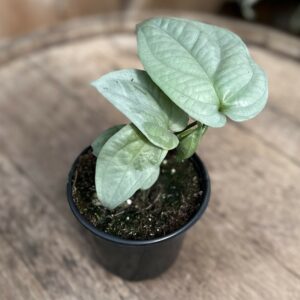
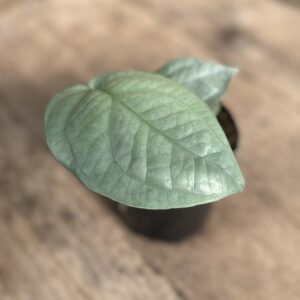
$29.99
Amydrium medium ‘Silver’ Care
Light: Provide bright, indirect light for your Amydrium Medium Silver. It appreciates bright, filtered sunlight but should be protected from harsh direct sun exposure.
Temperature: Maintain a warm and consistent temperature between 65-80°F (18-27°C).
Humidity: Amydrium Medium Silver benefits from higher humidity levels.
Watering: Water the plant when the top inch of the soil feels dry to the touch. Water thoroughly, allowing excess water to drain from the pot.
Soil: Use a well-draining potting mix rich in organic matter. A mixture that includes peat moss, perlite, and orchid bark works well to provide good drainage.
Fertilization: Feed your Amydrium Medium Silver with a balanced liquid fertilizer every 4-6 weeks during the growing season (spring and summer).
-
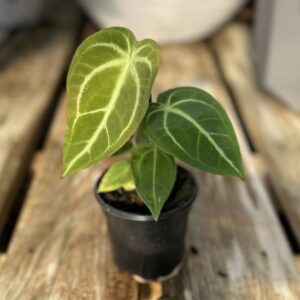
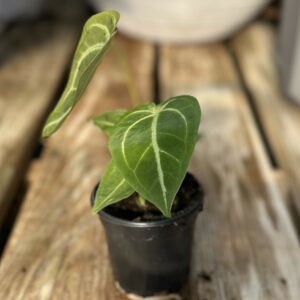
$34.99
Anthurium magnificum Care
Light: Provide bright, indirect light for your Anthurium magnificum. It appreciates filtered sunlight or dappled shade. Avoid exposing it to direct sunlight, as this can scorch the leaves.
Watering: Keep the soil consistently moist but not waterlogged. Water when the top inch of the soil feels slightly dry. Anthuriums do not like to dry out completely, so maintaining a consistent level of moisture is essential.
Humidity: Anthurium magnificum thrives in high humidity. Regular misting or placing the plant on a tray filled with water and pebbles can help create a more humid environment. Grouping plants together can also increase humidity levels.
Soil: Plant your Anthurium magnificum in a well-draining, peat-based potting mix. A mix formulated for orchids or aroids works well. Ensure the pot has drainage holes to prevent waterlogging.
Temperature: Maintain a warm environment for your Anthurium magnificum. It prefers temperatures between 65°F to 80°F (18°C to 27°C). Protect it from drafts and sudden temperature fluctuations.
Fertilization: Feed your Anthurium magnificum with a balanced liquid fertilizer every 4-6 weeks during the growing season (spring and summer). Reduce or eliminate fertilization in the fall and winter when the plant is not actively growing.
-
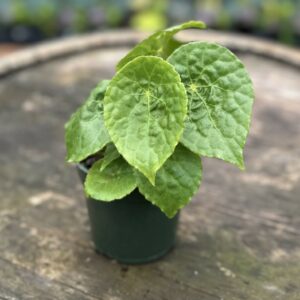
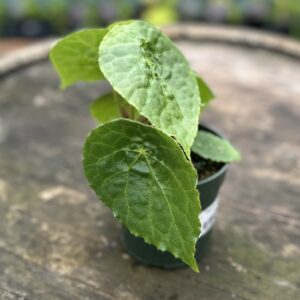
$12.99
Begonia natunaensis Care
Light: Bright, indirect light; avoid direct sunlight.
Watering: Keep soil consistently moist but not waterlogged.
Humidity: Prefers higher humidity; mist occasionally.
Temperature: Maintain temperatures between 65-75°F (18-24°C).
Soil: Use well-draining, peat-based potting mix.
Fertilization: Feed monthly with a balanced liquid fertilizer during the growing season.
-

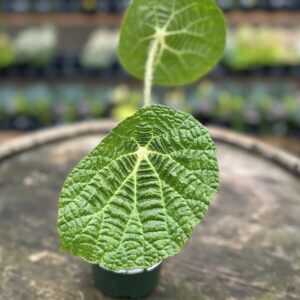
$19.99
Begonia paulensis Care
Light: Filtered to medium indirect light; avoid direct sunlight.
Watering: Keep soil consistently moist but not waterlogged.
Humidity: High humidity; mist regularly or use a humidifier.
Temperature: Maintain temperatures between 65-75°F (18-24°C).
Soil: Use well-draining, peat-based potting mix.
Fertilization: Feed monthly with a balanced liquid fertilizer during the growing season.
-

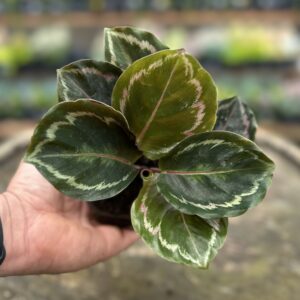
$16.99
Calathea ‘Medallion’ Care
Light: Medium to low indirect light; avoid direct sunlight.
Watering: Keep soil consistently moist but not waterlogged.
Humidity: High humidity; mist regularly or use a humidifier.
Temperature: Maintain temperatures between 65-80°F (18-27°C).
Soil: Use well-draining, peat-based potting mix.
Fertilization: Feed monthly with a balanced liquid fertilizer during the growing season.
-
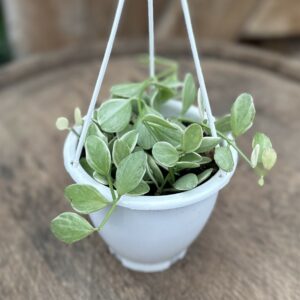

$29.99
Dischidia Care
Light: Provide bright, indirect light for your Dischidia. It appreciates plenty of natural light but should be protected from direct sunlight, which can scorch its delicate leaves. A north or east-facing window with filtered sunlight is ideal.
Temperature: Maintain a warm and consistent temperature. Dischidia prefers temperatures between 65°F to 75°F (18°C to 24°C). Avoid exposing it to cold drafts or sudden temperature fluctuations.
Pot and Soil: Plant your Dischidia in a well-draining orchid or epiphytic mix. These plants are epiphytic, meaning they naturally grow on other surfaces like tree branches, so a lightweight, well-draining mix is essential. Ensure the pot has good drainage.
Watering: Keep the soil slightly moist but not waterlogged. Water sparingly, but thoroughly, allowing the top inch of the potting mix to dry out between waterings. Watering from the bottom of the pot can be beneficial. Avoid getting water on the leaves, as they are susceptible to rot when wet.
Humidity: Dischidia enjoys higher humidity levels, so misting the plant regularly or using a humidity tray can help. Grouping it with other plants can also create a microclimate with increased humidity.
Fertilization: Feed your Dischidia sparingly. Use a balanced, water-soluble fertilizer diluted to half the recommended strength. Fertilize every 2-3 months during the growing season (spring and summer) and reduce or stop fertilization during the dormant period (fall and winter).
-

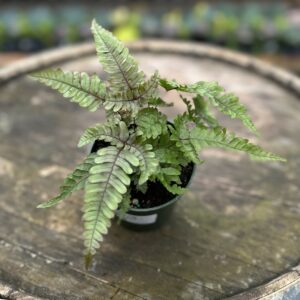
$12.99
Fern Tricolor Care
Light: Indirect light to partial shade; avoid direct sunlight.
Watering: Keep soil consistently moist; avoid waterlogging.
Humidity: High humidity; mist regularly or use a humidifier.
Temperature: Maintain temperatures between 60-75°F (15-24°C).
Soil: Use well-draining, peat-based potting mix.
Fertilization: Feed monthly with a balanced liquid fertilizer during the growing season.
-

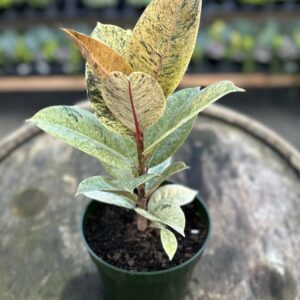
$29.99
Ficus elastica ‘Shivereana’ Care
Light: Bright, indirect light. Tolerates lower light conditions.
Temperature and Humidity: Between 65°F to 75°F (18°C to 24°C). Can tolerate average indoor humidity, but appreciates higher humidity levels.
Watering: Allow the top inch (2.5 cm) of the soil to dry out between waterings. Water thoroughly when you do water, ensuring that excess water drains from the pot.
Soil: Well-draining potting mix appropriate for indoor plants.
Fertilizing: Feed with a balanced liquid fertilizer diluted to half strength every 4-6 weeks during the growing season (spring and summer).
-

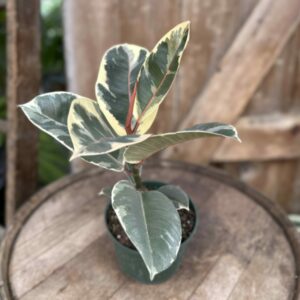
$19.99
Ficus Elastica ‘Tineke’ Care
Light: Provide bright, indirect light for your Ficus elastica ‘Tineke.’ It tolerates lower light conditions, but its variegation will be more vibrant and prominent in medium to bright indirect light.
Temperature: Maintain a temperature range between 65°F to 75°F (18°C to 24°C).
Humidity: While Ficus elastica ‘Tineke’ can tolerate average indoor humidity, it appreciates slightly higher humidity levels.
Watering: Allow the top inch (2.5 cm) of the soil to dry out between waterings.
Soil: Use a well-draining potting mix appropriate for indoor plants. Adding perlite or sand can enhance drainage.
Fertilizing: Feed your Ficus elastica ‘Tineke’ with a balanced liquid fertilizer diluted to half strength every 4-6 weeks during the growing season (spring and summer).
-
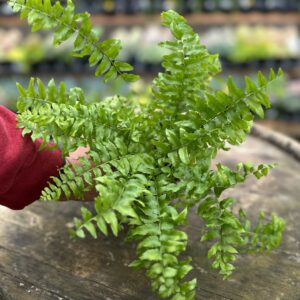

$12.99
Fishtail Fern Care
Light: Indirect to low light; avoid direct sunlight.
Watering: Keep soil consistently moist; do not allow to dry out completely.
Humidity: High humidity; mist regularly or use a humidifier.
Temperature: Maintain temperatures between 60-75°F (15-24°C).
Soil: Use well-draining, peat-based potting mix.
Fertilization: Feed monthly with a balanced liquid fertilizer during the growing season
-


$24.99
Ludisia Discolor Nigrescens Care
Light: Provide bright, indirect light for your Ludisia discolor ‘Nigrescens.’ It thrives in medium to low light conditions.
Temperature: Maintain a temperature range between 65°F to 75°F (18°C to 24°C).
Humidity: Ludisia discolor ‘Nigrescens’ prefers higher humidity levels. If the air is dry, mist the leaves regularly or use a humidity tray to maintain adequate moisture.
Watering: Keep the soil consistently moist but not waterlogged. Water when the top inch (2.5 cm) of the soil feels slightly dry.
Soil: Use a well-draining, porous orchid mix designed for epiphytic orchids.
Fertilizing: Feed your Ludisia discolor ‘Nigrescens’ with a balanced, diluted orchid fertilizer every 4-6 weeks during the growing season (spring and summer).
-


$34.99
Marble variegated epipremnum pinnatum Care
Light: This plant does well in moderate to bright indirect light.
Watering: Allow the top inch or two of the soil to dry out before watering.
Humidity: Marble Variegated Epipremnum Pinnatum thrives in higher humidity environments. If your indoor air is dry, consider using a humidity tray, a room humidifier, or mist the plant regularly to increase humidity.
Temperature: This plant prefers temperatures between 65-85°F (18-29°C).
Soil: Use a well-draining potting mix that retains some moisture but doesn’t get overly soggy.
Fertilization: During the growing season (spring and summer), feed the plant with a balanced, water-soluble fertilizer every 4-6 weeks.
-

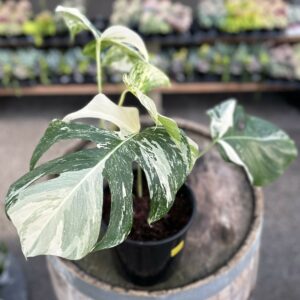
$269.99
Monstera borsigiana ‘Albo’ Care
Light: Provide bright, indirect sunlight for your Monstera borsigiana ‘Albo.’
Watering: Allow the top 1-2 inches of the soil to dry out before watering.
Humidity: Maintain higher humidity levels for your Monstera borsigiana ‘Albo.’
Temperature: Keep the plant in temperatures between 65-85°F (18-29°C).
Soil: Use a well-draining, aerated potting mix.
Fertilization: Feed your Monstera borsigiana ‘Albo’ with a balanced, diluted, water-soluble fertilizer during the growing season (spring and summer).
-
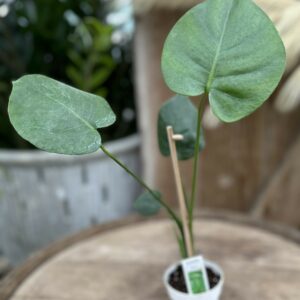
$9.99
Monstera deliciosa Care
Light: Provide bright, indirect sunlight for your Monstera deliciosa.
Watering: Allow the top inch or so of the soil to dry out before watering.
Humidity: Maintain higher humidity levels for your Monstera deliciosa, especially in drier indoor environments.
Temperature: Keep the plant in temperatures between 65-85°F (18-29°C).
Soil: Use a well-draining, aerated potting mix. A mix containing peat, perlite, and pine bark works well for Monstera deliciosa.
Fertilization: Feed your Monstera deliciosa with a balanced, diluted, water-soluble fertilizer every 4-6 weeks during the growing season (spring and summer).
-


$14.99
Monstera deliciosa Care
Light: Provide bright, indirect sunlight for your Monstera deliciosa.
Watering: Allow the top inch or so of the soil to dry out before watering.
Humidity: Maintain higher humidity levels for your Monstera deliciosa, especially in drier indoor environments.
Temperature: Keep the plant in temperatures between 65-85°F (18-29°C).
Soil: Use a well-draining, aerated potting mix. A mix containing peat, perlite, and pine bark works well for Monstera deliciosa.
Fertilization: Feed your Monstera deliciosa with a balanced, diluted, water-soluble fertilizer every 4-6 weeks during the growing season (spring and summer).






























